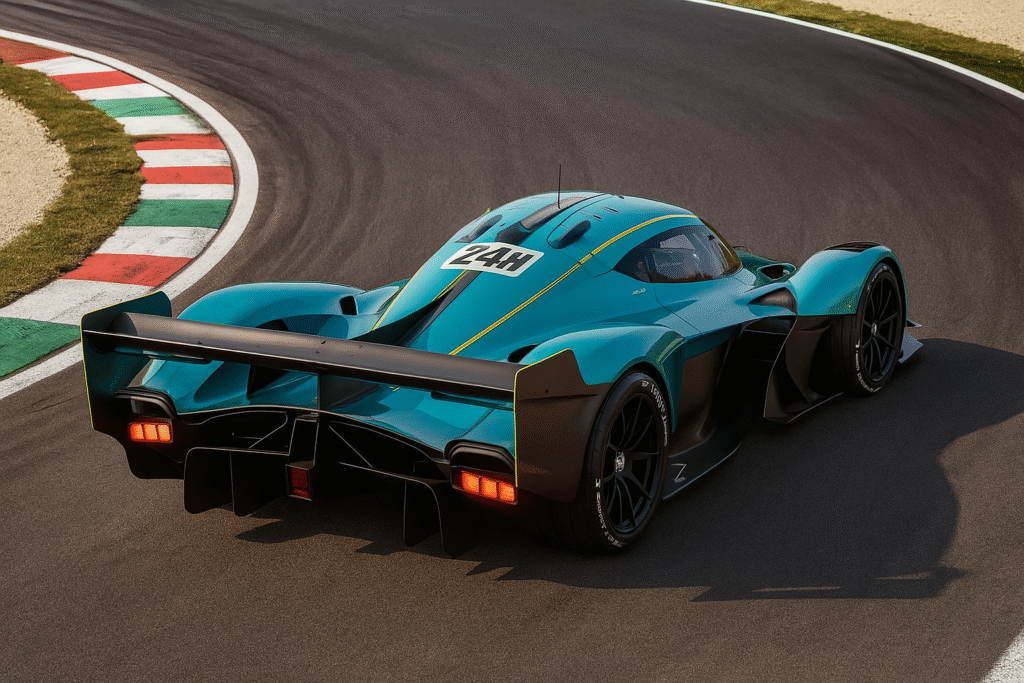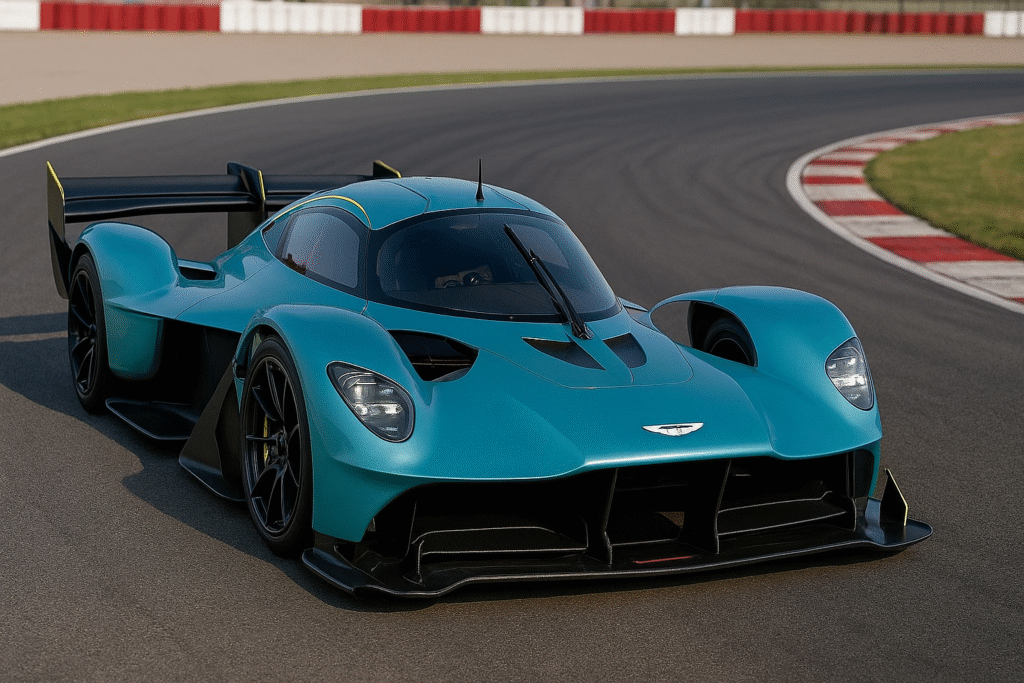
1. Aston Martin Valkyrie LM: The Ultimate Road-Legal Le Mans Hypercar
The Aston Martin Valkyrie LM isn’t just a car; it’s a statement of audacity. Born from Adrian Newey’s F1 genius and Aston Martin’s racing legacy, the “LM” (Le Mans) variant pushes the Valkyrie platform to its absolute limits while retaining just enough road legality. Forget compromises. This is a factory-built race car engineered to dominate circuits like Le Mans, yet paradoxically certified for the public highway.
Its existence defies conventional automotive logic, blending extreme aerodynamics, a naturally-aspirated V12 symphony, and space-grade materials into a machine that exists at the razor’s edge of performance. For the ultra-wealthy and motorsport-obsessed, the Valkyrie LM represents the pinnacle of attainable motorsport insanity.
2. Born for Endurance: The Valkyrie LM’s AMR Pro Racing DNA
The Valkyrie LM’s lineage is unmistakable. It’s the direct evolution of the track-only Valkyrie AMR Pro, itself conceived to compete in the now-cancelled Le Mans Hypercar (LMH) category. Aston Martin didn’t merely tweak the road-going Valkyrie; they reverse-engineered a monster. The LM inherits the AMR Pro’s extended wheelbase (+380mm), dramatically stretched bodywork, and colossal aerodynamic surfaces.
This transformation wasn’t for aesthetics; it was mandatory for high-speed stability during the brutal 24 Hours of Le Mans. Think of the LM as the AMR Pro’s slightly tamer sibling – tamer only in the sense it has headlights, a license plate bracket, and a whisper of sound deadening. Underneath, its soul is pure, unadulterated endurance racer.
3. Cosworth’s Fury: Inside the Valkyrie LM’s 1,130 HP V12 Powerhouse

At the heart of the Valkyrie LM beats a masterpiece: the Cosworth-built 6.5-liter naturally aspirated V12. This engine is a mechanical symphony and an engineering rebellion in an era dominated by turbochargers and hybridization. While the standard Valkyrie couples this V12 with a hybrid system, the LM strips away the electric motors and batteries. Why? Brutal simplicity and weight savings.
The result is a pure, 1,130 horsepower (at a screaming 10,500 RPM) and 740 lb-ft of torque internal combustion engine. Its 12,100 RPM redline isn’t just a number; it’s an eardrum-shattering declaration of analog fury. The LM’s power-to-weight ratio exceeds that of a modern F1 car, translating to savage acceleration and a top speed brushing 250+ mph. This engine isn’t merely powerful; it’s a cultural artifact, potentially the last of its kind.
4. Weaponized Aerodynamics: How the LM Generates 1,800 kg of Downforce
Forget wings; the Valkyrie LM wears an aero arsenal. Every curve, vent, and blade serves a purpose dictated by Adrian Newey’s ground-effect mastery, honed in Formula 1. The extended bodywork channels air with ruthless efficiency. The towering rear wing, massive front splitter, and intricate underbody tunnels work in concert to suck the car onto the tarmac, generating a staggering 1,800 kg (nearly 4,000 lbs) of downforce at high speed.
This isn’t just about cornering grip; it’s about stability at 200+ mph and braking forces that defy physics. The LM’s aero doesn’t just work with the car; it becomes the car’s defining characteristic, creating a visual presence as aggressive as its performance. This level of downforce, achievable on a road-legal vehicle, is unprecedented and borderline absurd.
5. Carbon Fiber Chassis: The Skeleton of a Track Weapon
Lightweighting is gospel for the Valkyrie LM. Its core is an F1-inspired carbon fiber monocoque tub, forming an incredibly stiff and featherweight safety cell. Every suspension component, body panel, and structural element is crafted from advanced composites. This obsessive focus on mass reduction means the LM weighs in at approximately 1,000 kg (2,200 lbs) – roughly half the weight of a typical supercar.
The consequences are profound: explosive acceleration, telepathic handling response, and unrivaled agility. The suspension itself is a work of art – inboard pushrod-actuated with multi-way adjustable dampers, mirroring F1 practice to minimize unsprung weight and maximize aerodynamic efficiency under the body. This chassis isn’t built for comfort; it’s built for transmitting every nuance of the track directly to the driver.
6. Track-Focused Interior: Where F1 Meets Hypercar Minimalism
Step inside the Valkyrie LM, and the race car intent is overwhelming. Forget plush leather and wood trim; this is a cockpit sculpted for speed. The driver sits reclined, feet elevated, strapped in by a six-point harness, peering through an F1-style rectangular steering wheel at a single, central digital display.
The wheel itself is cluttered with essential controls – pit lane speed, DRS, brake bias, engine modes. Passenger? Only one, squeezed into an equally spartan seat. Sound deadening is virtually non-existent; the V12’s roar is your soundtrack. Storage? Non-existent beyond tiny nets. Air conditioning? An optional extra, highlighting the car’s “road legal” status is a technicality. This interior is a brutalist temple to performance, demanding total focus from its occupant.
7. Valkyrie LM vs. Valkyrie AMR Pro: Road-Legal vs. Track-Only Titans
Understanding the Valkyrie LM requires comparing it to its track-only sibling, the AMR Pro:
- Purpose: LM = Road-Legal Track Weapon; AMR Pro = Pure Race Car (no concessions).
- Engine: LM = 6.5L V12 (1,130 HP) Naturally Aspirated; AMR Pro = 6.5L V12 + Hybrid (1,160 HP+).
- Hybrid: LM = None; AMR Pro = Yes (provides torque fill, regen braking).
- Aero Downforce: LM = ~1,800 kg; AMR Pro = Significantly Higher (no regulations).
- Weight: LM = ~1,000 kg; AMR Pro = Lighter (no road equipment).
- Comfort/Features: LM = Minimal (AC optional, basic lights); AMR Pro = None.
- Top Speed: LM = ~250+ mph; AMR Pro = Higher (less drag, more power/aero).
- Production: LM = 40 units; AMR Pro = Limited run (exact numbers undisclosed).
The Verdict: The LM sacrifices ultimate track performance (AMR Pro) for the unique privilege of being driven legally to the circuit. It’s the most extreme car you could theoretically park outside a restaurant.
8. Exclusivity Defined: Why Only 40 Valkyrie LMs Exist
The Valkyrie LM’s price tag (estimated $3.5 – $4 Million USD) is only part of its exclusivity story. Aston Martin capped production at a mere 40 units globally. This scarcity isn’t marketing fluff; it reflects the immense complexity, bespoke construction, and hand-built nature of each car.
Securing an allocation required not just deep pockets but often prior history with Aston Martin’s Special Operations (Q Division) or significant motorsport involvement. Owners aren’t just buying a car; they’re joining an ultra-elite fraternity with access to private track events and factory support. This exclusivity guarantees the LM’s status as a future blue-chip collectible, destined for climate-controlled collections and concours d’elegance fields.
9. Ownership Reality: Price, Maintenance & the Ultimate Garage Queen
Owning a Valkyrie LM transcends typical hypercar stewardship. Beyond the multi-million-dollar purchase price, expect astronomical running costs:
- Maintenance: Servicing requires factory-trained technicians and specialized tools. Annual costs easily reach six figures.
- Tires: Bespoke, track-focused rubber wears rapidly; a set can cost $20,000+.
- Transport: Moving the LM requires enclosed, specialized transport.
- Driving: It’s extremely wide, very low, and incredibly loud. Daily driving is impractical bordering on impossible. Public roads barely scratch its performance potential.
- Storage: Requires climate-controlled, secure garage space.
- Depreciation? Likely minimal or even negative long-term, given rarity and significance.
Ownership is less about driving and more about custodianship of a technological icon. It’s the ultimate “Garage Queen” – admired, occasionally exercised on track days, and preserved for history.
10. Legacy Unleashed: Is the Valkyrie LM the Greatest Aston Martin Ever Built?
The Valkyrie LM stands as a watershed moment for Aston Martin. It represents the culmination of ambition, technical partnership (Red Bull Advanced Technologies, Cosworth), and a daring disregard for convention. While cars like the DB5 or DBR1 hold historical significance, the LM claims the mantle of ultimate performance expression. It embodies Adrian Newey’s F1 genius translated to the road (barely) and serves as a swan song for the high-revving, naturally aspirated hypercar.
It pushes boundaries in aerodynamics, materials science, and lightweighting to levels previously unseen outside a racetrack. Is it the “greatest”? Subjectively, perhaps not for purists of classic GT design. But objectively, in terms of engineering audacity, performance limits, and sheer rarity, the Valkyrie LM is Aston Martin’s undisputed technological apex predator. It’s a car that redefines the possible, ensuring its legend will resonate for decades.
Also Read:
2026 Range Rover Velar: Stunning New Features, Powerful Performance & Full Review
FAQs:
What is the Aston Martin Valkyrie LM?
A road-legal, track-focused hypercar evolved from the Le Mans-ready AMR Pro, limited to 40 units.
How much horsepower does the Valkyrie LM have?
1,130 HP from its Cosworth 6.5L naturally aspirated V12 (no hybrid system).
What’s the top speed of the Valkyrie LM?
250+ mph (400+ km/h), enabled by radical aerodynamics and lightweight design.
How much downforce does it generate?
~1,800 kg (4,000 lbs) at high speed – unprecedented for a road-legal car.
What’s the price of the Aston Martin Valkyrie LM?
~$3.5-4 million USD, making it one of the world’s most exclusive hypercars.
Valkyrie LM vs. AMR Pro: What’s the difference?
LM is road-legal, lighter (no hybrid), less downforce; AMR Pro is track-only, hybrid-powered, more extreme.